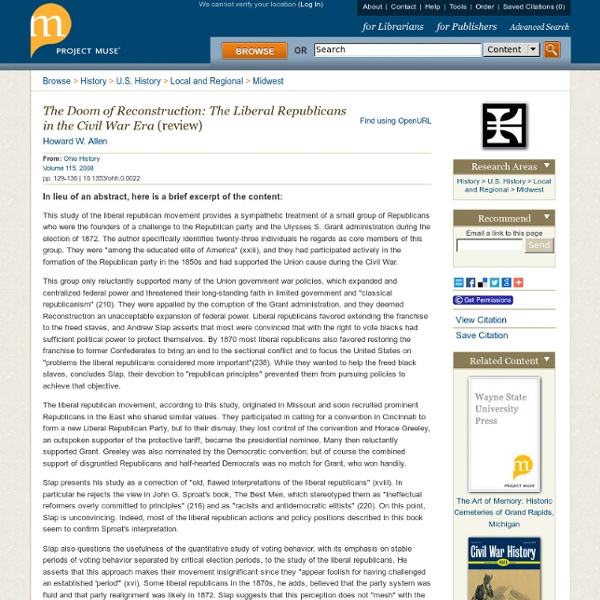Sharecropping and tenant farming
Sharecropping was common throughout the South well into the twentieth century, and required the work of entire families. In this famous photograph, a six year-old girl picks cotton in Oklahoma. (Photograph by Lewis W. Hine. More about the photograph) After the Civil War, thousands of former slaves and white farmers forced off their land by the bad economy lacked the money to purchase the farmland, seeds, livestock, and equipment they needed to begin farming.
TENANT FARMING AND SHARECROPPING
When the Civil War ended, the big question concerned the state of the freed slaves of the South. Recovery of the southern economy depended on getting the freedmen back into the cotton fields. During the period of Reconstruction the Radical Republicans in Congress tried to convert the freedmen into small free-holding farmers, but the former slaves were simply not ready to manage their own farms. What emerged out of necessity was southern farm tenancy, a system of near slavery without legal sanctions. Instead of working in gangs as they had on antebellum plantations, the freedmen became tenants. The planter or landowner assigned each family a small tract of land to farm and provided food, shelter, clothing, and the necessary seeds and farm equipment.
Carpetbaggers & Scalawags - American Civil War
In general, the term “carpetbagger” refers to a traveler who arrives in a new region with only a satchel (or carpetbag) of possessions, and who attempts to profit from or gain control over his new surroundings, often against the will or consent of the original inhabitants. After 1865, a number of northerners moved to the South to purchase land, lease plantations or partner with down-and-out planters in the hopes of making money from cotton. At first they were welcomed, as southerners saw the need for northern capital and investment to get the devastated region back on its feet. They later became an object of much scorn, as many southerners saw them as low-class and opportunistic newcomers seeking to get rich on their misfortune.
Passage of the Fifteenth Amendment . U.S. Grant: Warrior . WGBH American Experience
Harper's Weekly Magazine An illustration of blacks in line to vote At the time of Ulysses S. Grant's election to the presidency in 1868, Americans were struggling to reconstruct a nation torn apart by war. Voting rights for freed blacks proved a big problem. Reconstruction Acts passed after the war called for black suffrage in the Southern states, but many felt the approach unfair.
About Sharecropping
About Sharecropping SharecroppingTrudier Harris A practice that emerged following the emancipation of African-American slaves, sharecropping came to define the method of land lease that would eventually become a new form of slavery.
14th Amendment
Amendment XIV Section 1. All persons born or naturalized in the United States, and subject to the jurisdiction thereof, are citizens of the United States and of the state wherein they reside.
Civil Rights Act of 1866 Facts, information, pictures
Christopher A. Bracey The Civil Rights Act of 1866 (14 Stat. 27) was a momentous chapter in the development of civic equality for newly emancipated blacks in the years following the Civil War. The act accomplished three primary objectives designed to integrate blacks into mainstream American society. First, the act proclaimed "that all persons born in the United States ... are hereby declared to be citizens of the United States."
Scalawags and Carpetbaggers
A temporary political vacuum existed in the postwar South. Confederate military and political leaders were temporarily prohibited from participating in the political process. Republican governments filled the void and were able to retain control by depending upon the votes of the newly enfranchised blacks. Blacks were vital to the process, but that did not mean that they ran affairs. Two groups actually pulled the strings of government:
The Ku Klux Klan in the 1920s . Fatal Flood . WGBH American Experience
Library of Congress A speech given by LeRoy Percy convinced the citizens of Greenville to support a resolution condemning the Klan The Ku Klux Klan was founded in 1866 by ex-Confederate soldiers and other Southerners opposed to Reconstruction after the Civil War. In the waning years of Reconstruction the Klan disbanded. Nearly 50 years later, in 1915, "Colonel" William Joseph Simmons, revived the Klan after seeing D. W.
Reconstruction - American Civil War
At the outset of the Civil War, to the dismay of the more radical abolitionists in the North, President Abraham Lincoln did not make abolition of slavery a goal of the Union war effort. To do so, he feared, would drive the border slave states still loyal to the Union into the Confederacy and anger more conservative northerners. By the summer of 1862, however, the slaves themselves had pushed the issue, heading by the thousands to the Union lines as Lincoln’s troops marched through the South.
Reconstruction: The Second Civil War
The Civil Rights Act of 1866 granted citizenship and the same rights enjoyed by white citizens to all male persons in the United States "without distinction of race or color, or previous condition of slavery or involuntary servitude." President Andrew Johnson's veto of the bill was overturned by a two-thirds majority in both houses of Congress, and the bill became law. Johnson's attitude contributed the growth of the Radical Republican movement, which favored increased intervention in the South and more aid to former slaves, and ultimately to Johnson's impeachment. 1866 Civil Rights Act 14 Stat. 27-30, April 9, 1866 A.D.
The Rise and Fall of Jim Crow . Jim Crow Stories . The Ku Klux Klan
The Ku Klux Klan was originally organized in the winter of 1865-66 in Pulaski, Tennessee as a social club by six Confederate veterans. In the beginning, the Klan was a secret fraternity club rather than a terrorist organization. (Ku Klux was derived from the Greek "kuklos," meaning circle, and the English word clan.)



